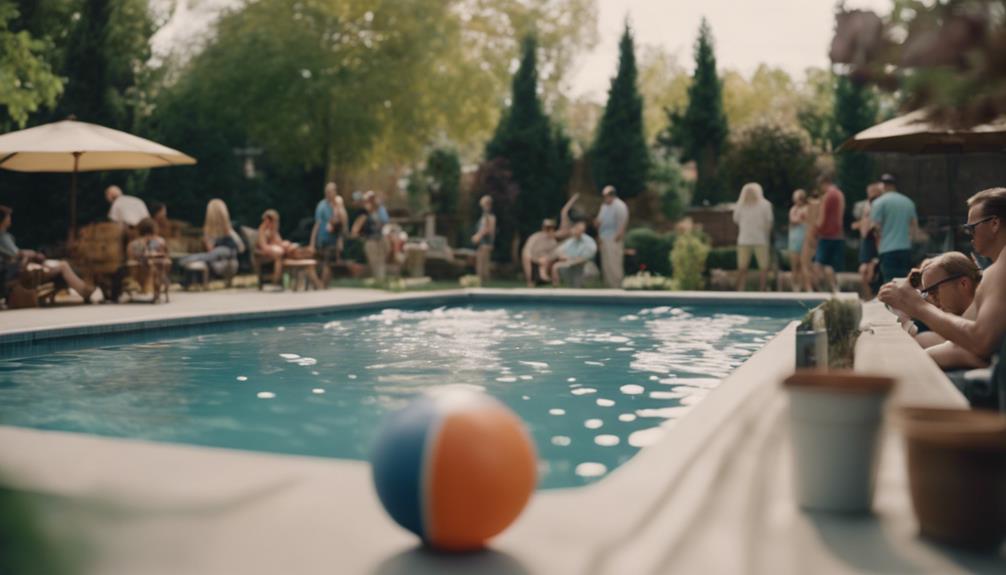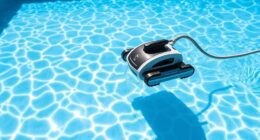To understand the anatomy of a pool, it's important to grasp the key components that operate harmoniously for water maintenance. Skimmers play a significant role in maintaining water clarity by removing debris, while main drains prevent pump dry runs. Return jets are crucial in distributing clean water throughout the pool, ensuring proper circulation. Filtration systems are essential to keeping pool water free from contaminants and debris. Pool water types, suction functions, filtration systems, installation considerations, and the important elements that make up a pool all contribute to its functionality. Further exploration will unravel the intricacies of pool anatomy.
Key Takeaways
- Skimmers remove debris for water clarity.
- Main Drains prevent pump dry runs.
- Return Jets distribute clean water.
- Sand Filters are cost-effective, lasting 5-8 years.
- Diatomaceous Earth Filters trap small particles.
Pool Water Types
Freshwater and saltwater pools offer distinctive advantages, each presenting unique benefits to pool owners.
Freshwater pools, commonly filled with city water, well water, or transported water, provide a more familiar swimming experience for many individuals. City water quality varies based on the municipality's size and water treatment processes. Well water, while cost-effective, may contain minerals necessitating consistent treatment. Transported water, albeit the most expensive option, offers a convenient solution for filling pools.
On the other hand, saltwater pools utilize a chlorinator to convert salt into chlorine, providing softer water that is gentler on the skin and eyes. Understanding the differences between freshwater and saltwater pools is essential for pool owners when deciding on the best option for their needs.
Suction Functions
Understanding the mechanics of a pool's suction functions is essential to maintaining efficient water circulation and cleanliness. To guarantee optimal operation, the following key points should be considered:
- Skimmers: These components are designed to remove debris such as dirt, oil, leaves, and bugs from the pool water, helping to keep it clean and clear.
- Main Drains: Positioned in the deepest part of the pool, main drains serve the critical function of preventing the pump from running dry, thereby ensuring the continuous operation of the pool system.
- Multiple Skimmers: Most pools are equipped with at least two skimmers to enhance the efficiency of debris removal and maintain water clarity.
Filtration Systems

What role do filtration systems play in maintaining clean and clear pool water?
Filtration systems are essential components of pool maintenance, responsible for keeping pool water free from debris and contaminants. Return jets play an essential role in increasing water circulation, aiding in the filtration process.
There are different types of filters available, each with its unique advantages. Sand filters, the least expensive option, typically last 5-8 years. Diatomaceous Earth filters are highly efficient at trapping small particles, ensuring crystal-clear water. Cartridge filters are recommended for smaller pools due to their ability to remove more dirt than sand filters.
Properly functioning filtration systems are essential for preventing stagnation and maintaining pristine pool water quality.
Swimming Pool Installation
When contemplating swimming pool installation, it is crucial to make informed decisions regarding pool design and equipment selection. Proper planning can secure the functionality and longevity of your pool.
Here are three key factors to ponder during the installation process:
- Site Assessment: Conduct a thorough evaluation of the installation site to determine factors such as soil composition, drainage, and access for construction equipment.
- Permitting and Regulations: Familiarize yourself with local building codes and regulations governing pool installations to secure compliance and avoid potential legal issues.
- Budgeting: Establish a realistic budget that accounts for all aspects of the installation, including excavation, equipment, landscaping, and potential unforeseen expenses. A well-planned budget can help prevent financial setbacks during the installation process.
Pool Anatomy Key Elements

The fundamental components of a pool's anatomy play essential roles in its operation and maintenance. Here is a breakdown of key elements found in a typical pool:
| Component | Function | Importance |
|---|---|---|
| Skimmers | Remove debris like dirt, oil, leaves, and bugs | Maintain water clarity |
| Main Drains | Prevent the pump from running dry | Guarantee pool operational capabilities |
| Return Jets | Increase water circulation in the pool | Distribute clean water throughout the pool |
| Sand Filters | Least expensive filtration option | Last 5-8 years |
| Diatomaceous Earth Filters | Efficient at trapping small particles | Ensure complete filtration |
Frequently Asked Questions
How Often Should Pool Water Be Tested for Chemical Balance?
To maintain a safe and enjoyable swimming environment, pool water should be tested for chemical balance at least twice a week. Regular testing guarantees proper pH, alkalinity, and sanitizer levels, preventing issues and preserving water quality.
What Is the Ideal Depth for a Pool's Main Drains?
When considering the ideal depth for a pool's main drains, safety and efficiency are paramount. The standard recommendation is to place main drains at the deepest part of the pool, typically 18 inches below the water surface, ensuring proper water circulation and pump functionality.
Can Pool Water Be Recycled or Reused for Other Purposes?
Pool water can be recycled or reused for other purposes through processes like filtration, treatment, and disinfection. Recycling options vary based on water quality, local regulations, and available technologies, offering sustainable solutions for water conservation.
How Do You Prevent Algae Growth in a Pool?
To prevent algae growth in a pool, maintain proper water chemistry by regularly testing and balancing pH, chlorine, and alkalinity levels. Regularly clean and brush the pool walls and floor, guarantee proper filtration, and consider using algaecides as a preventative measure.
What Is the Best Way to Winterize an Outdoor Pool?
The best way to winterize an outdoor pool involves balancing the pool's chemistry, lowering the water level, cleaning the pool thoroughly, covering it with a quality pool cover, and shutting down the filtration system to prevent damage during the winter months.
Conclusion
To sum up, understanding the anatomy of a pool is essential for proper maintenance and efficient functioning.
For instance, a case study of a pool owner who neglected regular maintenance and ended up with a clogged filtration system and dirty water highlights the significance of consistent upkeep.
By familiarizing themselves with the key components and functions of a pool, owners can guarantee a clean and enjoyable swimming experience for themselves and their guests.










